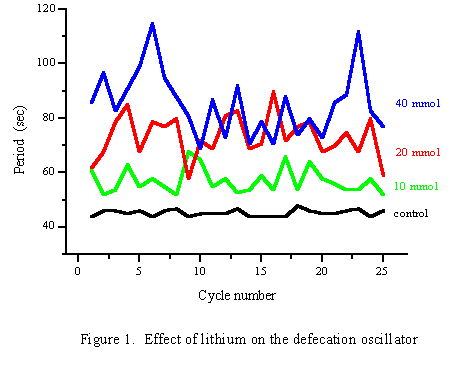
Worm Breeder's Gazette 16(4): 26 (October 1, 2000)
These abstracts should not be cited in bibliographies. Material contained herein should be treated as personal communication and should be cited as such only with the consent of the author.
Institute of Cell, Animal and Population Biology, University of Edinburgh, King's Buildings, Edinburgh EH9 3JN. E-mail f.kippert@ed.ac.uk
Lithium is a unique pharmacological reagent for biological rhythm research as it has been found to lengthen the period of circadian clocks in all cases studied. No other reagent with such a universal effect has been described. In human medicine, lithium has been used for many decades in the treatment of some depressive disorders. Since the circadian system is perturbed in the affected depressive patients, a link between the period lengthening effect of lithium and its therapeutic effect has been proposed. However, the mode of action of lithium on rhythms and in the treatment of depression is still unknown.
Numerous rhythms with other, non-circadian, periods have also been found to have their periods lengthened by lithium. We have therefore initiated a study of its effect on the defecation oscillator of C. elegans. Adults were found to be unsuitable for this program because the large variability of period for individual animals and between animals, as well as the profound effect of age on period, are not compatible with routine studies. Thus we have used L4 larvae as this stage has a very regular period.
L3 were transferred in the evening onto plates with a range of lithium concentrations and defecation was recorded the next day for 15 cycles per L4. A dose response-curve was established with an increase from 49.3 ± 2.1 sec in the control to 83.4 ± 9.3 sec at 40 mmol lithium. This period lengthening is the highest found for any biological rhythm so far. Even further period lengthening was observed at higher concentrations. However, determining a mean period was not practicable because at these concentrations larvae occasionally stopped defecating for 6 or more minutes. With increasing lithium concentrations, the period become increasingly irregular with the mean coefficient of variation of the 15 cycles per animal increasing from 4.7 % in the control to 23.7 % at 40 mmol. Figure 1 shows typical examples of a control and of L4s on 10, 20 and 40 mmol lithium.
When L4 were transferred to lithium and monitored, it was found that it took several hours before period lengthening occurred. This would be compatible with the depletion of a required substance or the accumulation of a toxic substance and may therefore give first indications as to the underlying mechanisms. Another important finding is that the lithium effect on period is completely reversible. This is also true with the inhibitory effect of lithium on development observed at higher concentrations.
The pronounced effect of lithium and the high reproducibility of the L4 system make this an excellent model for the molecular genetic analysis of the lithium effect. In particular, it will be important to determine what role the members of the inositol monophosphatase and glycogen synthase kinase-3 gene families play in the lithium effect on biological rhythms. Since C. elegans, in contrast to higher eukaryotes, has only six genes belonging to these two families, we pursue this aspect using a gene by gene approach.
